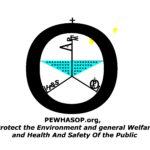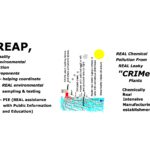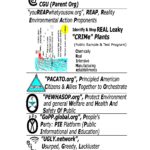ATTENTION Michigan EGLE (Environment, Great Lakes and Energy) Lansing Headquarters and Grand Rapids District Office: Materials Management Division (Waste Compliance Enforcement Section), Environmental Investigation Section, Remediation & Redevelopment Division and Water Resources Division,
PayPal Donation Link: https://www.paypal.com/donate?hosted_button_id=AHH32GGSRLEWJ
Re: Commencement of Leaky CRIMe Plant Citizens’ Sample & Test Program (CSTP)
ANNOUNCEMENT: After over 20 years of State of Michigan ignoring the leaky CRIMe plant problem (Chemically Real Intensive Manufacturing establishments), we are now going to initiate the “Citizen Sample & Test Program (CSTP)”. And we are not asking local and state public officials (elected & appointed) for your permission, we are simply telling you we are proceeding and doing what you all should have been doing for the last half century since RCRA & HSWA passed in 1976 & 1984 respectively. The former Michigan DEQ, never hesitated to clamp down harshly on Ma & Pa gas stations and dry cleaners under the 1988 UST program (Underground Storage Tanks), forcing many of these small businesses with noncompliant USTs into bankruptcies. While at the same time, when it came to larger “lobbyist protected” OEM supply chain leaky CRIMe plants (e.g., electroplating plants, leather tanneries etc ), they were all given a FREE PASS by MDEQ falsely based on some cockamamie attorney interpreted concocted inapplicable RCRA hazardous waste exemption/exclusion [40 CFR Section 261.4(a)(1)] intended for POTWs (and not CRIMe plants), that MDEQ naively were led to believe gave these plants with leaky underground pipes and tanks carrying hazardous wastewater full rights to freely pollute the land and water with no subsequent investigations and consequences.
We will start this Citizen Sample & Test Program (CSTP) with Leaky CRIMe plant in vicinity of 1648 Monroe Ave NW, Grand Rapids, MI, 700’ east of Grand River, that the MI AG (Granholm) was first made aware of in March 2000 (and State notified repeatedly thereafter). Next to be sampled/tested will be the Leaky CRIMe plant in vicinity of 4260 Airlane Dr SE, Kentwood MI, on Plaster Creek at a site which once was a “greenfield space” which has since turned “brown”. What will be obvious from test results from samples collected down gradient of either of these two sites, will be the presence of toxic chemicals that make up the “chemical fingerprint” (which ain’t rocket science) of the CRIMe manufacturing processes conducted at these two facilities. Keep in mind, that there are hundreds (and perhaps thousands) of highly suspected leaky CRIMe plants like these scattered throughout Michigan yet to be sampled/tested, and across the US there are upwards of ten thousand or more of these highly suspected leaky CRIMe plants that have been ignored by regulators for the mere reason that the area where they are located is publicly served by central water. The latter should not be adequate reason to let these CRIMe plants continually and freely pollute the surrounding land and water. Now getting back to the Monroe plant, don’t be fooled by the nice fancy painted metal facade on this plant – this is a very old plant with antiquated below-grade old pipes, sumps and tanks used to convey, store and treat hazardous process wastewater. Prior to 2000, leakage from this plant (hexavalent chromium etc.) was evident in a well located on the west side of plant, coincidentally installed while a UST (gas) was being removed off the property. Underground highly contaminated aquifer flow from this location flows directly to the Grand River just 700 feet to the west through a highly porous granular geologic formation (virtually acting much like an open conduit), which happens to be the upper reach of the planned and imminent Grand River commercial/recreational Restoration Project that is being touted as a “full-body contact” recreational surface water linear park for wading, swimming, kayaking, etc. Those downstream from this project, including the public at large, and the three public waterworks (Grand Haven, Grand Rapids & Wyoming) with several drinking water intake structures near the mouth of the river out in Lake Michigan, better take heed to the pile of toxic chemicals coming their way when all the dams are removed in the Grand River Restoration Project, which will certainly be releasing many tons of toxic industrial chemicals that have accumulated for over a century on the river bottom behind these several dams. Michigan has never given the Leaky CRIMe plant much attention, because centralized public water is available, and detrimental effects of cancer caused by the toxic leakage (e.g., leakage into areas where children play, like basements, ditches, streams, contaminated ponds & in groundwater sprinkler irrigation systems) takes decades to occur and you all know full well it is difficult to impossible to legally to trace this dreaded disease back to the exact source.
So in the near future, when the groundwater test results are available from the CSTP, we will first share those results “live” at a regularly scheduled County and City Commissioners’ meetings so they can be heard out loud by concerned citizens and be part of the record, with the purpose of making it less likely that a public official sworn to protect the public’s wellbeing and health & safety will be able to put this information in the “circular file” or “recycle bin” or bury it deep in the government archives. It is often said, “If you want to get something done, sometimes it’s best to take matters into your own hands” rather than relying on those who are elected or appointed and sworn to perform those functions.
For anyone, anything and anytime, there are always consequences for your actions and inactions. An example of the latter would be someone (infant, toddler or adult) dying from cancer caused by Leaky CRIMe plant pollution. The latter is, and was, well known, and could have, and should have, been prevented if lobbyists, consultants, attorneys, public officials (latter and big corps are all on big conveyor belt where they continually swap jobs) and regulators didn’t let and enable CRIMe plants to arbitrarily contort exemptions/exclusions to falsely allow them to freely pollute our environment. For all of the aforementioned Leaky CRIMe plant enablers, think of all your actions/inactions as analogous to the recent high rise building collapse in FL: On any given night when you go to sleep after local and state public officials have repeatedly failed to enact and/or enforce building structural safety regulations (and condo assn boards fail to act on bldg repair recommendations), you reach over for your “very old To Do List of the morally and ethically right things you should be doing” and in the process you knock over your glass of water that shatters as it hits the tile floor, after which the whole building suddenly collapses from under you. Because of your procrastination, deliberate or otherwise, the list never got done.
People have been bamboozled into thinking that the hazardous waste (HW) pollution problem in the US has been solved in the distant past by the laws previously mentioned, which resulted in the creation of 4000 EPA licensed HW TSDFs (Treatment, Storage & Disposal Facilities) that now properly receive, store, treat (and recycle) and dispose of all the HW generated at some forty to fifty thousand CRIMe plants operated throughout the US. The latter includes about 20,000 metal finishing/electroplating plants in the US. The off-site TSDFs that manufacturers ship their HW to (in solid and liquid form) must meet strict requirements on conveyance, storage and treatment of the HWW (hazardous wastewater) they receive from the CRIMe plants, yet the CRIMe plants themselves do not meet these strict requirements for the high volume of hazardous process wastewater they treat at their industrial sites. The EPA permitted and enforced requirements that the licensed TSDFs must meet for HWW received, include: (a) all conveyance and storage systems must have secondary containment with a leak detection system between the primary and secondary containment (i.e., must have a “tank in a tank”, and a “pipe in a pipe”); (b) the latter systems must have continuous automatic monitoring for tank/pipe liquid level or pressure with an automatic alarm and shutdown system to prevent primary or secondary containment overflow or spillage/leakage; (c) surface water and groundwater must be routinely sample and tested around the site and at the property line for purpose of contamination detection and early notification on whether any groundwater contamination has occurred so corrective action can be taken immediately, and adjoining property owners can be notified of the problem; and (d) must perform extensive facilities and site inspections and monitoring reports, subject to EPA regulatory review.
THE PROBLEM IS THAT THE TOTAL OF ALL THESE CRIMe PLANTS IN THE USA TREAT A LOT MORE HAZARDOUS WASTE (in gallons or tons) COLLECTIVELY THAN ALL THE EPA LICENSED TSDFs, YET THE CRIMe PLANTS ARE NOT MEETING ANY OF THE ABOVE REQUIREMENTS. How much more? We don’t know, but it could be a hundred thousand times more or greater. Additionally, the design and construction of the TSDF (performed and overseen by professional engineer), and the preparation of an operational plan thereof, is strictly reviewed for compliance to all the applicable EPA regulations. Whereas, in most cases across the US, there is no government entity that does the same for CRIMe plants when they are first constructed or modified/expanded (i.e., no regulatory review or requirements by the local, state or federal government relative to compliance with applicable hazardous waste RCRA or HSWA regulations). Some will say that the CRIMe plant must meet the CWA (Clean Water Act) requirements through the local POTW through their sewer CWA NPDES discharge permit for their discharge to the municipal sewer after first treating the HWW. But the problem with that, is that a Leaky CRIMe plant (say 10 to 15% leakage), more often than not, is not getting all the HWW generated from the manufacturing production process to the sewer because 10% or more of this process HWW is leaking to the soils and groundwater below the plant from these leaky buried tanks and pipes. Others will say that the CRIMe plant has to get a building permit from the local building inspector. But the problem with that is that the City building inspector only cares about how many parking spaces do you have, have you met handicap requirements and minimum requirements for fire safety, electrical and HVAC requirements, etc. So as you can see, this is a major loophole, and please don’t think that all these CRIMe plants are going good at self-regulating and they have just been getting better and better and more compliant over the years even though there is less and less CRIMe plant regulatory enforcement and inspections, because in fact, a lot of them do plant construction/modifications without using a licensed professional engineer, and instead use in-house engineers, who aren’t college educated in engineering, and only got the title of company engineer because they got promoted to that position after being a plating technician, electrician or a plumber. On the point of underground leakage (also overflow spillage) from CRIMe plants, the quantities of HWW leaked to the environment in total over the years can be very substantial. For example, if a moderate size plater produces 100,000 gallons per day (gpd) of HWW from its manufacturing process (which would not be unusual), and has even 5 % leakage, that’s 5,000 gpd of HWW being released to the soils and groundwater. Annually with 330 production days, that amounts to 1.65 million gallons per year. Let’s say that half the CRIMe plants in the US that aren’t compliant (due to lack of state & federal regulatory enforcement) with the RCRA/HSWA hazardous waste laws have a similar amount of HWW leakage to the environment. First of all, realize that these CRIMe plants and their attorneys claim, through a warped interpretation of the regulations, that they are exempt from hazardous waste RCRA/HSWA laws because of an exemption/exclusion in the law for domestic sewage, which was intended for POTWs only (and not CRIMe plant HW generators) so municipal wastewater plants could accept sewer discharges from these hazardous waste generating CRIMe plants after they have treated HWW on-site. Again, if half the CRIMe plants in the US are leaking a similar amount of HWW to the environment as given in the prior example of a moderate plater, that would amount to annual leakage of HWW to the environment of 33 billion gallons (1.65 million gal X 20,000 CRIMe plants). Keep in mind that this is for toxic chemicals (hexavalent chromium, PFAS/PFOS, etc.) that have health concentration standards that are in the parts per billion or parts per trillion range (i.e., just trace amounts can cause cancer, especially to most vulnerable population, such as pregnant women, unborn, infants and toddlers).
So, in summary, I have no doubt that there is a steady faucet flowing from leakage from CRIMe plants that has been occurring unnoticed for half century, and is insidiously and accumulatively polluting our land and water resources, including the degradation of our drinking water supply sources, such as in the Great Lakes Region. This is a BIG HUGE PROBLEM that has knowingly (by perpetrators, and local, state and federal governments) been going on for over a half century and is negligently being ignored. The reason this problem I have described is not being detected, is because these CRIMe plants are located in areas served by centralized public drinking water systems and nobody is sampling and testing the groundwater around these plants for contaminants emanating from the CRIMe plant because nobody is drinking that contaminated groundwater directly and NOBODY IS DROPPING DEAD (the health effects of carcinogens often takes decades to appear in the human body). Realize that the hydrological system is all interconnected, so all the polluted groundwater from the tens of thousands of leaky CRIMe plants is now (or soon will be) collectively flowing together through all the aquifers, ditches, creeks, streams and rivers, and is insidiously accumulating in the lakes or aquifers we use for our public drinking water resources. You may ask: who would ever pay for the sampling and testing around a CRIMe plant? Certainly, the CRIMe plant won’t, and likely the local or state government won’t because they don’t want to upset local or state employment or the economy, and the politicians who represent these jurisdictions don’t want to get involved because they know for the same reasons stated, it would hurt their reelection potential. And the other thing that keeps local, state and federal public elected officials from supporting a sample and test program for these suspected leaky CRIMe plants, is that don’t want to upset the automotive OEM “just in time” supply chain from parts suppliers. Additionally, the property owners around the leaky CRIMe plant are hesitant to sample and test because they don’t want their property values to go down. So who does that leave to support and help finance the CRIMe plant sample and test program? The only possibility is the chance that philanthropists and the general public (small donations) will (and have) contribute to a nonprofit organization dedicated to the promotion, management, administration, financing and implementing of such a program based on a priority system starting with those CRIMe plants that are suspected the most of having antiquated and poorly designed, constructed and maintained HWW conveyance, storage and treatment systems. In other words, if a CRIMe plant LACKS adequate environmental safeguards, leakage and pollution to the environment is occurring and those plants should be targeted in the Leaky CRIMe Plant Sample & Test Program.
If Michigan and other states cared enough about the public’s wellbeing and health & safety, they could end the Leaky CRIMe plant problem if they took action similar to state of California. After repeatedly noticing that the worse kind of HW violations in their state (Class I violations) were almost always associated with below-grade pipes and tanks carrying hazardous wastewater (HWW), CA decided to outlaw the existence of buried pipes and tanks for conveying, storing and treating HWW. It’s the obvious answer and the RIGHT ANSWER for ending Leaky CRIMe plants, and should be mandated in all the states. CA defines HW Class I violations as acts that are done Willfully, Intentionally, Knowingly and Negligently, and are often associated with CRIMe plants that are Chronic and Recalcitrant Violators and the violations they are committing represent a Significant Threat to human health or safety or environment due to volume of waste, toxicity of waste, and proximity of at risk population (e.g., pregnant women, infants, toddlers). And Class I violations enables the violator to benefit from noncompliance economically by either reducing costs or competitive advantage. So Michigan how do you get out of this Leaky CRIMe plant predicament? You adopt a program like they have in CA by: (a) first make it mandatory that these CRIMe plants not be allowed to operate unless all pipes and tanks carrying HWW are clearly above grade (not buried or below the plant floor or ground anywhere on site) with secondary containment and are readily visible for inspection at anytime, including mandatory hourly inspection reports be kept and available, and any evidence of leakage of pipes or tanks or overflowing/spillage from tanks must be reported immediately when observed; (b) in lieu of latter hourly inspections, CRIMe plant may install automated continuous monitoring devices with automated alarm and shutoff systems that activate shutoff when there is detection of possible or pending (high liquid levels in tanks, low pressure levels in pipes) leakage or tank overflow/spillage; (c) there be leak detection systems for pipes and tanks with secondary containment, such as a “tank in a tank” and a “pipe in a pipe”, so it is clearly evident when the primary pipe or tank has failed as is leaking; and (d) CRIMe plants have environmental monitoring systems surrounding the plants within their property lines, including for surface water as applicable (stormwater ponds, etc.) and most definitely, for groundwater, including groundwater monitoring wells, so early detection and notification of contamination of surface/ground water will be known, so public may be immediately advised that chemical contamination is migrating and needs to be stopped and contained.
ANNOUNCEMENT: After over 20 years of State of Michigan ignoring the leaky CRIMe plant problem (Chemically Real Intensive Manufacturing establishments), we are now going to initiate the “Citizen Sample & Test Program (CSTP)”. And we are not asking local and state public officials (elected & appointed) for your permission, we are simply telling you we are proceeding and doing what you all should have been doing for the last half century since RCRA & HSWA passed in 1976 & 1984 respectively. The former Michigan DEQ, never hesitated to clamp down harshly on Ma & Pa gas stations and dry cleaners under the 1988 UST program (Underground Storage Tanks), forcing many of these small businesses with noncompliant USTs into bankruptcies. While at the same time, when it came to larger “lobbyist protected” OEM supply chain leaky CRIMe plants (e.g., electroplating plants, leather tanneries etc ), they were all given a FREE PASS by MDEQ falsely based on some cockamamie attorney interpreted concocted inapplicable RCRA hazardous waste exemption/exclusion [40 CFR Section 261.4(a)(1)] intended for POTWs (and not CRIMe plants), that MDEQ naively were led to believe gave these plants with leaky underground pipes and tanks carrying hazardous wastewater full rights to freely pollute the land and water with no subsequent investigations and consequences.
We will start this Citizen Sample & Test Program (CSTP) with Leaky CRIMe plant in vicinity of 1648 Monroe Ave NW, Grand Rapids, MI, 700’ east of Grand River, that the MI AG (Granholm) was first made aware of in March 2000 (and State notified repeatedly thereafter). Next to be sampled/tested will be the Leaky CRIMe plant in vicinity of 4260 Airlane Dr SE, Kentwood MI, on Plaster Creek at a site which once was a “greenfield space” which has since turned “brown”. What will be obvious from test results from samples collected down gradient of either of these two sites, will be the presence of toxic chemicals that make up the “chemical fingerprint” (which ain’t rocket science) of the CRIMe manufacturing processes conducted at these two facilities. Keep in mind, that there are hundreds (and perhaps thousands) of highly suspected leaky CRIMe plants like these scattered throughout Michigan yet to be sampled/tested, and across the US there are upwards of ten thousand or more of these highly suspected leaky CRIMe plants that have been ignored by regulators for the mere reason that the area where they are located is publicly served by central water. The latter should not be adequate reason to let these CRIMe plants continually and freely pollute the surrounding land and water. Now getting back to the Monroe plant, don’t be fooled by the nice fancy painted metal facade on this plant – this is a very old plant with antiquated below-grade old pipes, sumps and tanks used to convey, store and treat hazardous process wastewater. Prior to 2000, leakage from this plant (hexavalent chromium etc.) was evident in a well located on the west side of plant, coincidentally installed while a UST (gas) was being removed off the property. Underground highly contaminated aquifer flow from this location flows directly to the Grand River just 700 feet to the west through a highly porous granular geologic formation (virtually acting much like an open conduit), which happens to be the upper reach of the planned and imminent Grand River commercial/recreational Restoration Project that is being touted as a “full-body contact” recreational surface water linear park for wading, swimming, kayaking, etc. Those downstream from this project, including the public at large, and the three public waterworks (Grand Haven, Grand Rapids & Wyoming) with several drinking water intake structures near the mouth of the river out in Lake Michigan, better take heed to the pile of toxic chemicals coming their way when all the dams are removed in the Grand River Restoration Project, which will certainly be releasing many tons of toxic industrial chemicals that have accumulated for over a century on the river bottom behind these several dams. Michigan has never given the Leaky CRIMe plant much attention, because centralized public water is available, and detrimental effects of cancer caused by the toxic leakage (e.g., leakage into areas where children play, like basements, ditches, streams, contaminated ponds & in groundwater sprinkler irrigation systems) takes decades to occur and you all know full well it is difficult to impossible to legally trace this dreaded disease back to the exact source.
So in the near future, when the groundwater test results are available from the CSTP, we will first share those results “live” at a regularly scheduled County and City Commissioners’ meetings so they can be heard out loud by concerned citizens and be part of the record, with the purpose of making it less likely that a public official sworn to protect the public’s wellbeing and health & safety will be able to put this information in the “circular file” or “recycle bin” or bury it deep in the government archives. It is often said, “If you want to get something done, sometimes it’s best to take matters into your own hands” rather than relying on those who are elected or appointed and sworn to perform those functions.
For anyone, anything and anytime, there are always consequences for your actions and inactions. An example of the latter would be someone (infant, toddler or adult) dying from cancer caused by Leaky CRIMe plant pollution. The latter is, and was, well known, and could have, and should have, been prevented if lobbyists, consultants, attorneys, public officials (latter and big corps are all on big conveyor belt where they continually swap jobs) and regulators didn’t let and enable CRIMe plants to arbitrarily contort exemptions/exclusions to falsely allow them to freely pollute our environment. For all of the aforementioned Leaky CRIMe plant enablers, think of all your actions/inactions as analogous to the recent high rise building collapse in FL: On any given night when you go to sleep after local and state public officials have repeatedly failed to enact and/or enforce building structural safety regulations (and condo assn boards fail to act on bldg repair recommendations), you reach over for your “very old To Do List of the morally and ethically right things you should be doing” and in the process you knock over your glass of water that shatters as it hits the tile floor, after which the whole building suddenly collapses from under you. Because of your procrastination, deliberate or otherwise, the list never got done.
People have been bamboozled into thinking that the hazardous waste (HW) pollution problem in the US has been solved in the distant past by the laws previously mentioned, which resulted in the creation of 4000 EPA licensed HW TSDFs (Treatment, Storage & Disposal Facilities) that now properly receive, store, treat (and recycle) and dispose of all the HW generated at some forty to fifty thousand CRIMe plants operated throughout the US. The latter includes about 20,000 metal finishing/electroplating plants in the US. The off-site TSDFs that manufacturers ship their HW to (in solid and liquid form) must meet strict requirements on conveyance, storage and treatment of the HWW (hazardous wastewater) they receive from the CRIMe plants, yet the CRIMe plants themselves do not meet these strict requirements for the high volume of hazardous process wastewater they treat at their industrial sites. The EPA permitted and enforced requirements that the licensed TSDFs must meet for HWW received, include: (a) all conveyance and storage systems must have secondary containment with a leak detection system between the primary and secondary containment (i.e., must have a “tank in a tank”, and a “pipe in a pipe”); (b) the latter systems must have continuous automatic monitoring for tank/pipe liquid level or pressure with an automatic alarm and shutdown system to prevent primary or secondary containment overflow or spillage/leakage; (c) surface water and groundwater must be routinely sample and tested around the site and at the property line for purpose of contamination detection and early notification on whether any groundwater contamination has occurred so corrective action can be taken immediately, and adjoining property owners can be notified of the problem; and (d) must perform extensive facilities and site inspections and monitoring reports, subject to EPA regulatory review.
THE PROBLEM IS THAT THE TOTAL OF ALL THESE CRIMe PLANTS IN THE USA TREAT A LOT MORE HAZARDOUS WASTE (in gallons or tons) COLLECTIVELY THAN ALL THE EPA LICENSED TSDFs, YET THE CRIMe PLANTS ARE NOT MEETING ANY OF THE ABOVE REQUIREMENTS. How much more? We don’t know, but it could be a hundred thousand times more or greater. Additionally, the design and construction of the TSDF (performed and overseen by professional engineer), and the preparation of an operational plan thereof, is strictly reviewed for compliance to all the applicable EPA regulations. Whereas, in most cases across the US, there is no government entity that does the same for CRIMe plants when they are first constructed or modified/expanded (i.e., no regulatory review or requirements by the local, state or federal government relative to compliance with applicable hazardous waste RCRA or HSWA regulations). Some will say that the CRIMe plant must meet the CWA (Clean Water Act) requirements through the local POTW through their sewer CWA NPDES discharge permit for their discharge to the municipal sewer after first treating the HWW. But the problem with that, is that a Leaky CRIMe plant (say 10 to 15% leakage), more often than not, is not getting all the HWW generated from the manufacturing production process to the sewer because 10% or more of this process HWW is leaking to the soils and groundwater below the plant from these leaky buried tanks and pipes. Others will say that the CRIMe plant has to get a building permit from the local building inspector. But the problem with that is that the City building inspector only cares about how many parking spaces do you have, have you met handicap requirements and minimum requirements for fire safety, electrical and HVAC requirements, etc. So as you can see, this is a major loophole, and please don’t think that all these CRIMe plants are doing good at self-regulating and they have just been getting better and better and more compliant over the years even though there is less and less CRIMe plant regulatory enforcement and inspections, because in fact, a lot of them do plant construction/modifications without using a licensed professional engineer, and instead use in-house engineers, who aren’t college educated in engineering, and only got the title of company engineer because they got promoted to that position after being a plating technician, electrician or a plumber. On the point of underground leakage (also overflow spillage) from CRIMe plants, the quantities of HWW leaked to the environment in total over the years can be very substantial. For example, if a moderate size plater produces 100,000 gallons per day (gpd) of HWW from its manufacturing process (which would not be unusual), and has even 5 % leakage, that’s 5,000 gpd of HWW being released to the soils and groundwater. Annually with 330 production days, that amounts to 1.65 million gallons per year. Let’s say that half the CRIMe plants in the US that aren’t compliant (due to lack of state & federal regulatory enforcement) with the RCRA/HSWA hazardous waste laws have a similar amount of HWW leakage to the environment. First of all, realize that these CRIMe plants and their attorneys claim, through a warped interpretation of the regulations, that they are exempt from hazardous waste RCRA/HSWA laws because of an exemption/exclusion in the law for domestic sewage, which was intended for POTWs only (and not CRIMe plant HW generators) so municipal wastewater plants could accept sewer discharges from these hazardous waste generating CRIMe plants after they have treated HWW on-site. Again, if half the CRIMe plants in the US are leaking a similar amount of HWW to the environment as given in the prior example of a moderate plater, that would amount to annual leakage of HWW to the environment of 33 billion gallons (1.65 million gal X 20,000 CRIMe plants). Keep in mind that this is for toxic chemicals (hexavalent chromium, PFAS/PFOS, etc.) that have health concentration standards that are in the parts per billion or parts per trillion range (i.e., just trace amounts can cause cancer, especially to most vulnerable population, such as pregnant women, unborn, infants and toddlers).
So, in summary, I have no doubt that there is a steady faucet flowing from leakage from CRIMe plants that has been occurring unnoticed for half century, and is insidiously and accumulatively polluting our land and water resources, including the degradation of our drinking water supply sources, such as in the Great Lakes Region. This is a BIG HUGE PROBLEM that has knowingly (by perpetrators, and local, state and federal governments) been going on for over a half century and is negligently being ignored. The reason this problem I have described is not being detected, is because these CRIMe plants are located in areas served by centralized public drinking water systems and nobody is sampling and testing the groundwater around these plants for contaminants emanating from the CRIMe plant because nobody is drinking that contaminated groundwater directly and NOBODY IS DROPPING DEAD (the health effects of carcinogens often takes decades to appear in the human body). Realize that the hydrological system is all interconnected, so all the polluted groundwater from the tens of thousands of leaky CRIMe plants is now (or soon will be) collectively flowing together through all the aquifers, ditches, creeks, streams and rivers, and is insidiously accumulating in the lakes or aquifers we use for our public drinking water resources. You may ask: who would ever pay for the sampling and testing around a CRIMe plant? Certainly, the CRIMe plant won’t, and likely the local or state government won’t because they don’t want to upset local or state employment or the economy, and the politicians who represent these jurisdictions don’t want to get involved because they know for the same reasons stated, it would hurt their reelection potential. And the other thing that keeps local, state and federal public elected officials from supporting a sample and test program for these suspected leaky CRIMe plants, is that don’t want to upset the automotive OEM “just in time” supply chain from parts suppliers. Additionally, the property owners around the leaky CRIMe plant are hesitant to sample and test because they don’t want their property values to go down. So who does that leave to support and help finance the CRIMe plant sample and test program? The only possibility is the chance that philanthropists and the general public (small donations) will (and have) contribute to a nonprofit organization dedicated to the promotion, management, administration, financing and implementing of such a program based on a priority system starting with those CRIMe plants that are suspected the most of having antiquated and poorly designed, constructed and maintained HWW conveyance, storage and treatment systems. In other words, if a CRIMe plant LACKS adequate environmental safeguards, leakage and pollution to the environment is occurring and those plants should be targeted in the Leaky CRIMe Plant Sample & Test Program.
If Michigan and other states cared enough about the public’s wellbeing and health & safety, they could end the Leaky CRIMe plant problem if they took action similar to state of California. After repeatedly noticing that the worse kind of HW violations in their state (Class I violations) were almost always associated with below-grade pipes and tanks carrying hazardous wastewater (HWW), CA decided to outlaw the existence of buried pipes and tanks for conveying, storing and treating HWW. It’s the obvious answer and the RIGHT ANSWER for ending Leaky CRIMe plants, and should be mandated in all the states. CA defines HW Class I violations as acts that are done Willfully, Intentionally, Knowingly and Negligently, and are often associated with CRIMe plants that are Chronic and Recalcitrant Violators and the violations they are committing represent a Significant Threat to human health or safety or environment due to volume of waste, toxicity of waste, and proximity of at risk population (e.g., pregnant women, infants, toddlers). And Class I violations enables the violator to benefit from noncompliance economically by either reducing costs or competitive advantage. So Michigan how do you get out of this Leaky CRIMe plant predicament? You adopt a program like they have in CA by: (a) first make it mandatory that these CRIMe plants not be allowed to operate unless all pipes and tanks carrying HWW are clearly above grade (not buried or below the plant floor or ground anywhere on site) with secondary containment and are readily visible for inspection at anytime, including mandatory hourly inspection reports be kept and available, and any evidence of leakage of pipes or tanks or overflowing/spillage from tanks must be reported immediately when observed; (b) in lieu of latter hourly inspections, CRIMe plant may install automated continuous monitoring devices with automated alarm and shutoff systems that activate shutoff when there is detection of possible or pending (high liquid levels in tanks, low pressure levels in pipes) leakage or tank overflow/spillage; (c) there be leak detection systems for pipes and tanks with secondary containment, such as a “tank in a tank” and a “pipe in a pipe”, so it is clearly evident when the primary pipe or tank has failed and is leaking; and (d) CRIMe plants have environmental monitoring systems surrounding the plants within their property lines, including for surface water as applicable (stormwater ponds, etc.) and most definitely, for groundwater, including groundwater monitoring wells, so early detection and notification of contamination of surface/ground water will be known, so public may be immediately advised that chemical contamination is migrating and needs to be stopped and contained.
Fortunately for YouREAPwhatYouSow.org (Realty Environmental Action Proponents) and its parent organization, CommonGoodUnited.com (COMMONGOODUNITED INC) we have had plenty of support for our overall programs, and especially for the CSTP (Citizen’s Sample & Test Program), which has brought us to a point where we can now start bringing Realty to the public in the form of real test results so they can begin to learn how serious the Leaky CRIMe plant problem is, and how badly it has been swept under the manufacturing Lobbyist fulfilled rug.
Fortunately for YouREAPwhatYouSow.org (Realty Environmental Action Proponents) and its parent organization, CommonGoodUnited.com (COMMONGOODUNITED INC) we have had plenty of support for our overall programs, and especially for the CSTP (Citizen’s Sample & Test Program), which has brought us to a point where we can now start bringing Realty to the public in the form of real test results so they can begin to learn how serious the Leaky CRIMe plant problem is, and how badly it has been swept under the manufacturing Lobbyist fulfilled rug.


















